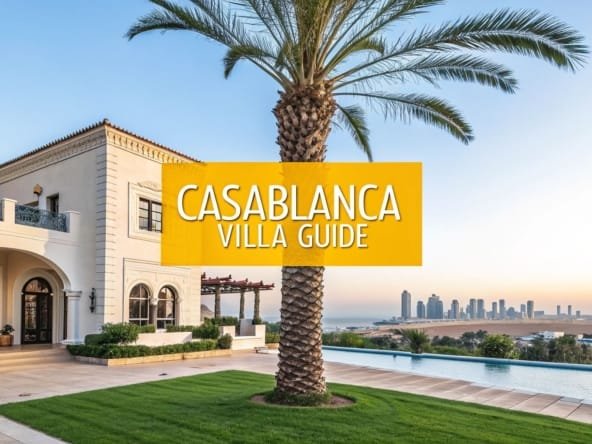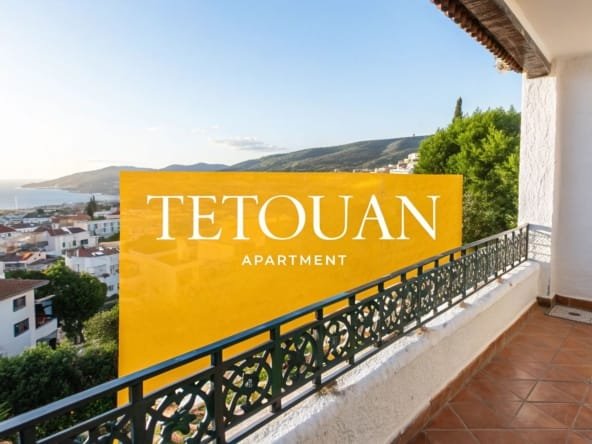Marrakech's bustling medina holds a serene secret: the riad garden. These enclosed courtyards are more than just green spaces; they are meticulously designed sanctuaries, blending art, nature, and architecture to create a private paradise. Understanding the key components of a traditional riad garden marrakech reveals centuries of cultural heritage and ingenious environmental design. These features are not merely decorative; they are foundational to the property's value, liveability, and appeal, offering crucial insights for potential investors and residents.
This guide delves into the seven essential features that define these urban oases, providing a clear framework for identifying authentic and well-preserved properties. For travellers, aspiring homeowners, and design enthusiasts alike, we will explore the elements that transform a simple courtyard into an enchanting Moroccan retreat. From the cooling whisper of a zellige fountain to the fragrant scent of citrus blossoms, this list offers a practical checklist for evaluating the quality and character of a Marrakech riad. For those seeking to invest or acquire, organisations specialising in the Moroccan market can provide expert guidance in sourcing properties that exemplify these timeless features, ensuring a sound and culturally rich investment.
1. The Foundational Heart: The Central Courtyard (Sahn)
The central courtyard, or sahn, is the quintessential element of any traditional Moroccan riad. It is more than just an architectural feature; it is the spiritual and functional heart of the home, embodying the Islamic concept of paradise on earth. This open-air space provides essential natural light and ventilation to the surrounding rooms, which all face inward, creating a private and serene sanctuary shielded from the city's hustle. The design of a classic riad garden marrakech courtyard is a masterclass in balance and harmony.
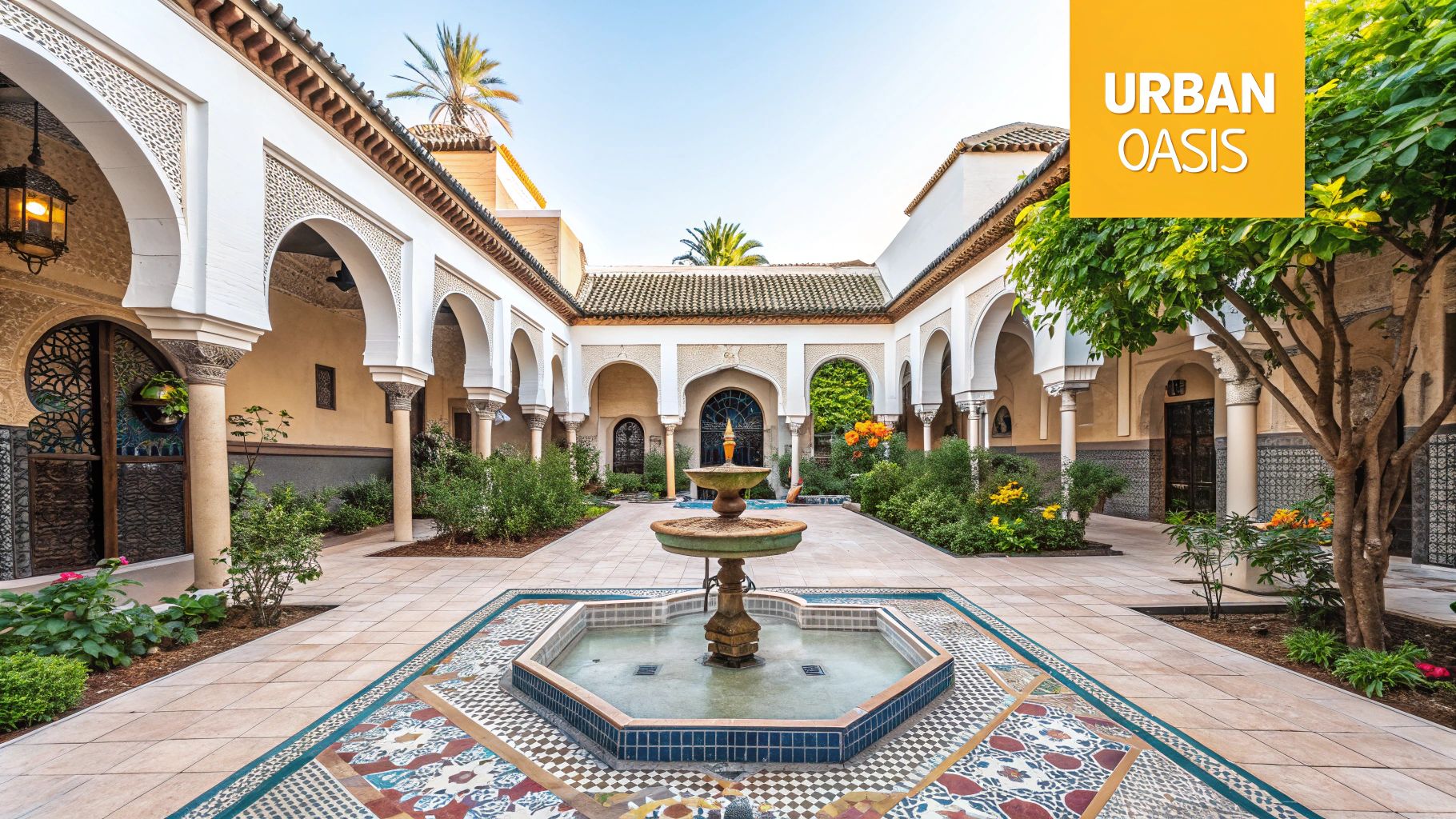
This foundational space traditionally follows the Persian chahar bagh (four-part garden) layout, with pathways or water channels dividing the area into four symmetrical quadrants. This geometric precision creates a sense of order and tranquillity, often centred around a fountain or plunge pool whose gentle sounds mask external noise and cool the air.
Exemplary Implementations
Many of Marrakech's most celebrated properties showcase the sahn to perfection. La Mamounia, after its renovation by Jacques Garcia, features courtyards that blend opulent detail with traditional structure. Riad Yasmine is famed for its iconic green-tiled pool set within a perfect chahar bagh design, a favourite on social media for its photogenic qualities. For ultimate privacy, the Royal Mansour offers individual riads, each with its own meticulously designed courtyard, demonstrating how the concept scales from grand to intimate.
Actionable Tips for Creating Your Courtyard
For those investing in or renovating a riad, focusing on the courtyard is paramount. Getting the foundation right ensures the entire property feels authentic and functional. If this concept intrigues you, exploring other top traditional riads to stay in Marrakech can offer further design inspiration.
- Prioritise Drainage: Before any planting or tiling, install a robust drainage system to handle both rainfall and water feature overflow.
- Use Authentic Materials: Source local stone like Bejmat or Zellige tiles for pathways and fountains to maintain architectural integrity.
- Balance Sun and Shade: Plan your planting to create a microclimate. Taller plants like citrus trees can provide necessary shade, while lower beds can host sun-loving flowers.
- Consider Sight Lines: Design the courtyard with the views from surrounding rooms and balconies in mind, ensuring the geometric flow and key features are visible.
- Integrate Seating: Incorporate built-in benches or alcoves that complement the garden's geometry rather than obstruct it, providing functional spaces for relaxation.
2. Mosaic Fountain (Fountain Zellige)
No riad garden marrakech is truly complete without the artistic and auditory centrepiece of a traditional zellige fountain. These handcrafted marvels are more than mere water features; they are a living expression of Moroccan heritage, showcasing centuries-old techniques of geometric tilework. The intricate patterns, often in deep blues, greens, and whites, reflect Islamic artistic principles of symmetry and infinity, turning a simple fountain into a mesmerizing work of art. The gentle sound of flowing water is fundamental, providing a soothing soundtrack that masks city noise and cools the courtyard air through natural evaporation.
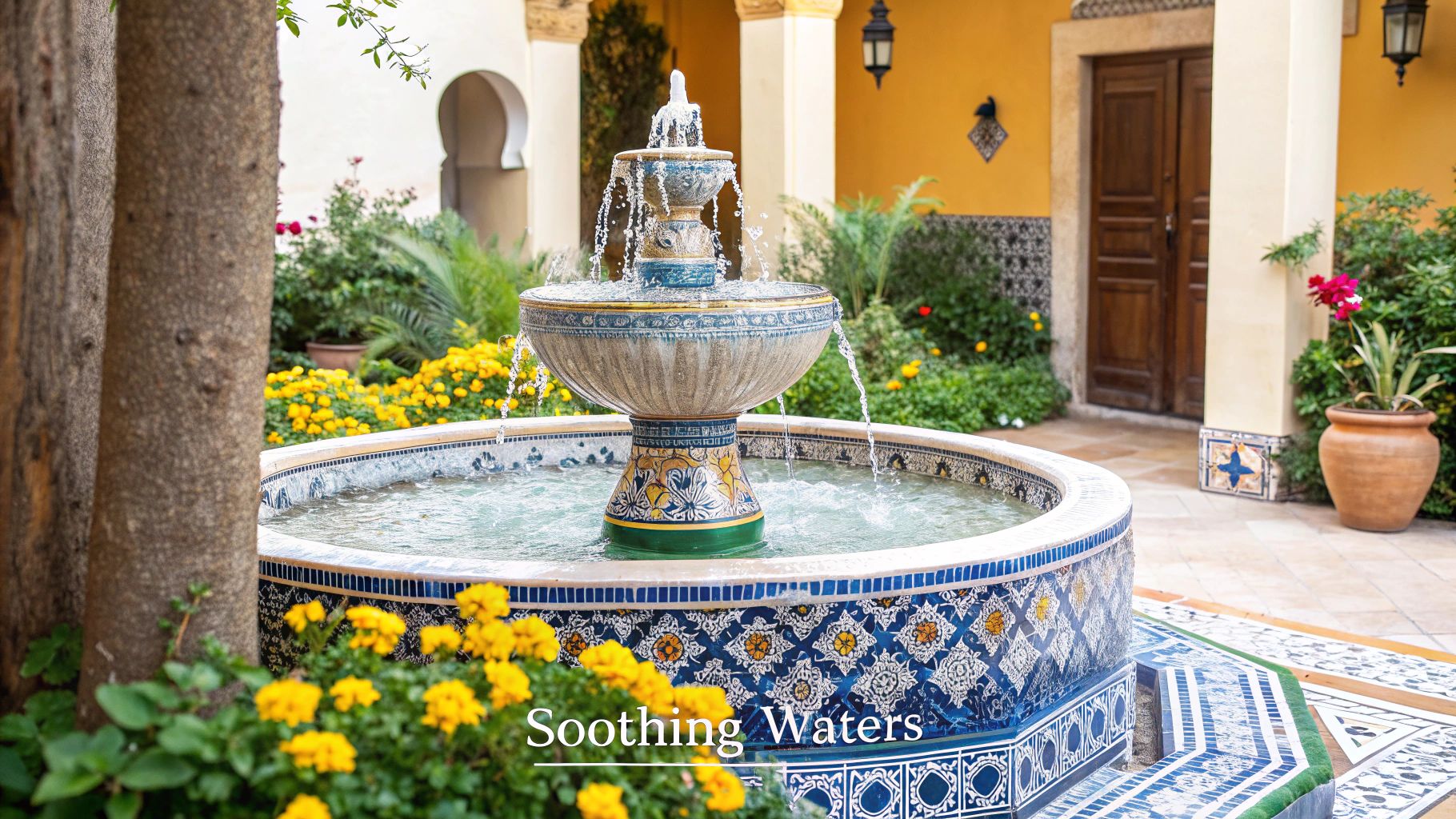
This tradition of meticulous craftsmanship, passed down through generations of maalem (master artisans), ensures each fountain is unique. The process involves hand-cutting glazed terracotta tiles into precise shapes, which are then arranged face-down in a mould before being set in plaster. The result is a vibrant, durable mosaic that serves as the visual anchor for the entire courtyard design, a practice popularized by designers like Jacques Majorelle and restoration specialists such as André Paccard.
Exemplary Implementations
Historical sites and luxury properties alike showcase the enduring appeal of zellige fountains. The Bahia Palace and the restored systems at the Saadian Tombs offer glimpses into the opulent use of this art form in royal contexts. In the hospitality world, boutique properties like Riad Kniza feature stunning central fountains that define their courtyards. Even grand hotels like La Mamounia incorporate Jacques Majorelle-inspired fountains, blending traditional craftsmanship with European design sensibilities.
Actionable Tips for Creating Your Fountain
For property owners, incorporating an authentic zellige fountain is a key investment in the aesthetic and sensory experience of a riad. To see how these elements come together in a modern, luxurious setting, you can find inspiration in a beautifully restored property like Riad Julia in Marrakech.
- Work with Certified Artisans: For authenticity and quality, commission your fountain from a certified maalem who understands traditional techniques.
- Prioritise Water Conservation: Install a modern recycling pump system to circulate water efficiently, minimising waste and environmental impact.
- Ensure Electrical Safety: The pump's electrical system must be properly grounded by a qualified electrician to prevent any safety hazards in a wet environment.
- Plan for Maintenance: Regularly clean the tiles with natural, non-abrasive solutions like white vinegar to remove lime scale and preserve the glaze.
- Highlight with Lighting: Install subtle, low-voltage up-lighting to accentuate the intricate tilework and the movement of the water during the evening.
3. Orange and Citrus Trees
No riad garden marrakech is truly complete without the presence of citrus trees, particularly the bitter orange (bigarade). These evergreen trees are more than simple decoration; they are a living heritage, providing essential shade, intoxicating fragrance from their blossoms, and vibrant colour with their fruit. Planted within the central courtyard, they create a vital vertical layer in the garden's design, drawing the eye upward and enhancing the sense of a private, verdant oasis.
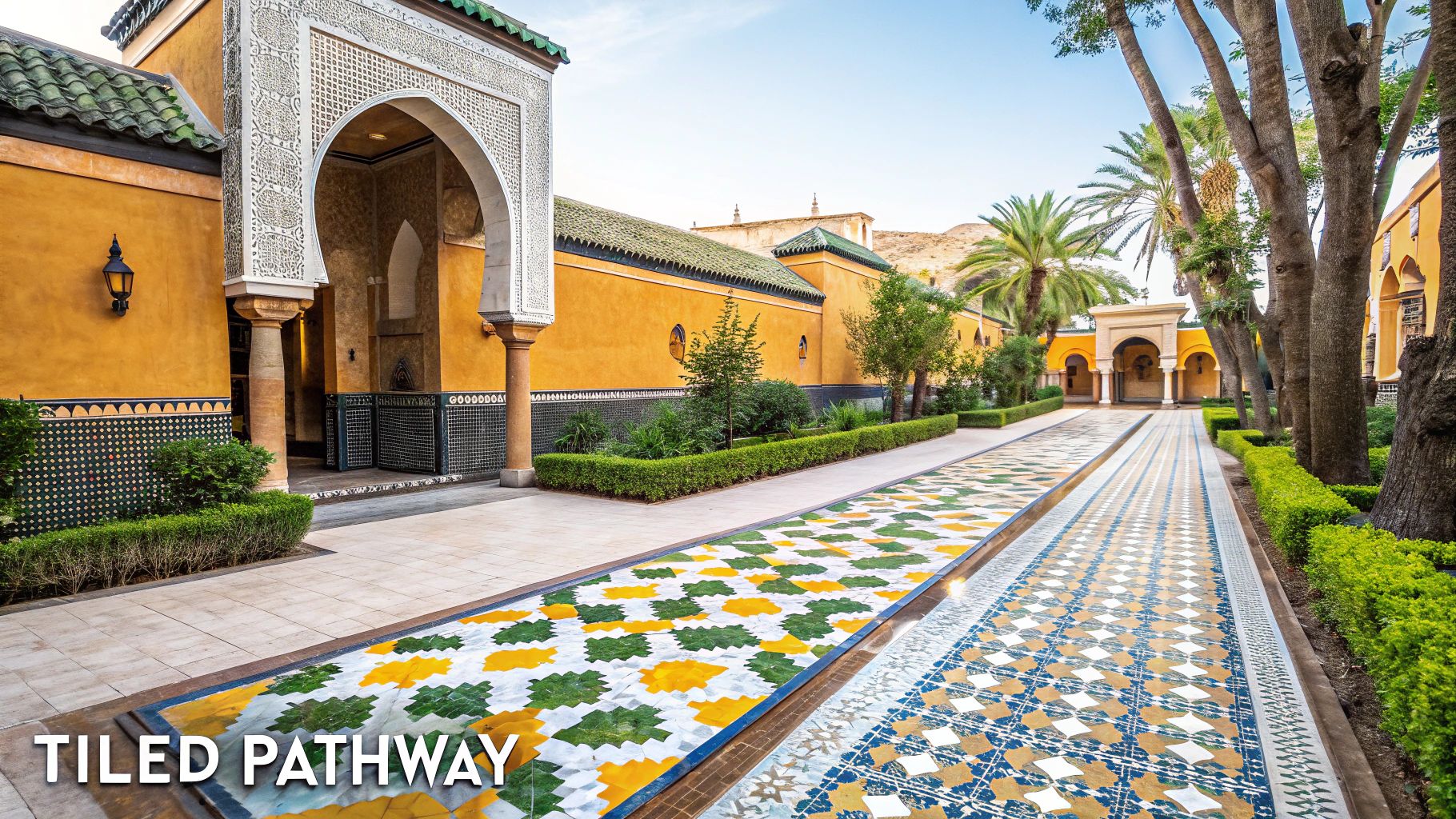
The tradition of cultivating citrus in Moroccan gardens dates back centuries, with the Almoravid dynasty introducing extensive groves in the 11th century. The trees are perfectly suited to the climate, their glossy green leaves providing year-round structure while their seasonal flowers and fruit perfume the air and offer a visual feast. Their inclusion connects a private riad to the city's grand agricultural traditions, echoing the historic orchards that surround Marrakech.
Exemplary Implementations
The influence of citrus is seen across Marrakech's most famous gardens. The Majorelle Garden features an extensive and artfully arranged citrus collection that complements its vibrant blue architecture. The historic Agdal and Menara Gardens showcase vast, traditional citrus orchards that have defined the landscape for centuries. On a more intimate scale, properties like Riad Tarabel masterfully integrate potted citrus trees into their rooftop terraces, demonstrating the versatility of these plants in smaller, structured spaces.
Actionable Tips for Cultivating Citrus
For property owners aiming to cultivate a classic riad garden, successfully growing citrus trees is a key achievement. It ensures the space feels, smells, and looks authentic. Their ability to thrive both in ground and in containers makes them adaptable to courtyards of any size.
- Ensure Excellent Drainage: Plant in well-draining soil enriched with organic matter to prevent root rot, a common issue for citrus.
- Provide Wind Protection: In exposed courtyards or on rooftops, shield young trees from strong winds that can damage blossoms and leaves.
- Use Large Containers: If potting, choose a large container (minimum 100 litres) to allow for adequate root growth and stability.
- Prune Strategically: Prune trees after the fruiting season has ended to maintain a desirable shape and encourage healthy new growth.
- Water Deeply: Once established, water deeply but infrequently, allowing the soil to dry slightly between waterings to promote strong roots.
4. Geometric Tile Pathways (Bejmat and Zellige)
The intricate pathways weaving through a riad garden marrakech are far more than simple walkways; they are the structural arteries of the design. Crafted from traditional Moroccan tiles, primarily bejmat (rectangular terracotta) and zellige (intricate glazed mosaics), these pathways guide movement, define planting beds, and form a stunning artistic framework. Reflecting complex Islamic mathematical principles, their geometric patterns create a visual rhythm that brings order and elegance to the entire garden space.
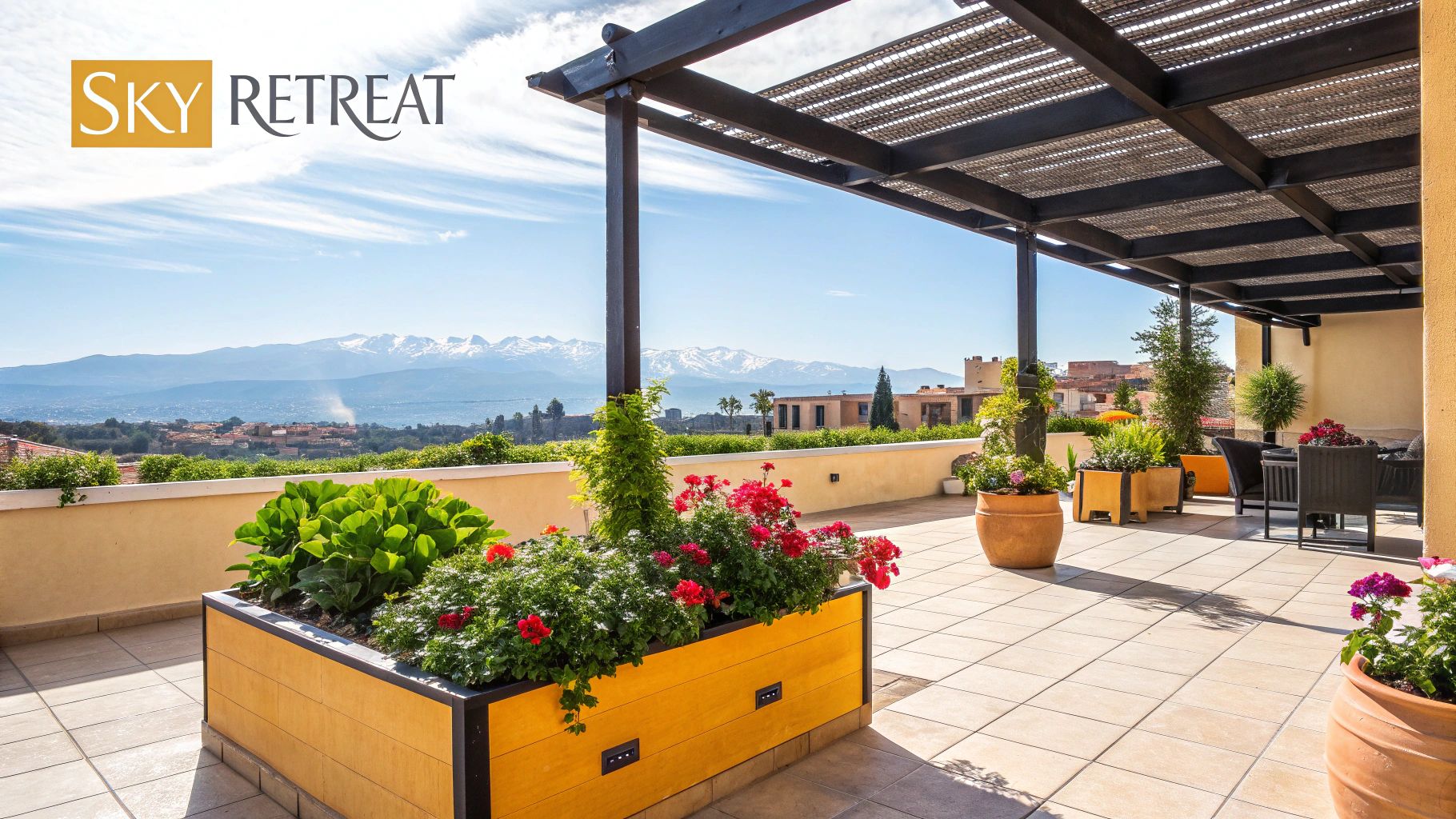
These tiled surfaces serve both a functional and aesthetic purpose. They connect different garden areas, such as the central fountain and surrounding seating alcoves, while their material and patterns contribute directly to the sensory experience. The earthy tones of bejmat and the vibrant hues of zellige contrast beautifully with the lush greenery, creating a composition that is both grounded and ornate, a hallmark of Moroccan design heritage popularised by Almoravid and Almohad craftsmen.
Exemplary Implementations
Historic sites offer unparalleled inspiration for tilework. The Bahia Palace in Marrakech showcases masterful courtyard pathways with incredibly complex patterns, demonstrating the peak of this art form. While now in ruins, the archaeological remnants at El Badi Palace hint at the grandeur of its original tiled walkways. In Fès, Riad Fès provides a superb example of restored traditional tile work, while the work of the late architect André Paccard in modern riads shows how these ancient techniques can be integrated into contemporary designs.
Actionable Tips for Creating Your Pathways
For those developing a riad property, the pathways are a crucial element that ties the garden together. Investing in authentic materials and craftsmanship pays dividends in both longevity and aesthetic appeal.
- Prepare the Substrate: Ensure a solid, well-compacted base is laid before tiling to prevent shifting and cracking over time.
- Plan for Drainage: Subtly slope the pathways away from building foundations and towards designated drainage points to manage rainwater effectively.
- Use Traditional Mortar: For an authentic installation and appearance, work with a maalem (master craftsman) who uses traditional lime mortar.
- Consider Anti-Slip Treatments: In areas prone to getting wet, especially around pools or fountains, apply an appropriate anti-slip sealant to enhance safety without compromising the tile's look.
- Document the Patterns: Photograph or sketch the tile patterns during installation. This record is invaluable for any future repairs or restoration, ensuring consistency can be maintained.
5. Rooftop Terrace Gardens
The rooftop terrace represents a modern evolution of the traditional riad, transforming a once-utilitarian space into an elevated garden sanctuary. It serves as a vital extension of the living area, offering panoramic views of the medina's skyline and the distant Atlas Mountains. These terraces are more than just viewpoints; they are meticulously designed riad garden marrakech spaces that provide a private escape from the city's energy below, capitalising on Morocco's generous sunlight.
Popularised during the modern riad restoration movement, these rooftop gardens often feature lush container planting, shaded pergolas, and comfortable seating areas. This design choice creates an additional layer of privacy and outdoor living, perfect for sunbathing, dining, or simply relaxing. The key challenge and art lie in selecting flora that can thrive in the more exposed, sun-drenched, and windy conditions of a rooftop environment.
Exemplary Implementations
Many Marrakech riads masterfully execute the rooftop garden concept. Riad Yasmine extends its iconic green aesthetic to a multi-level roof garden, offering intimate nooks and stunning city views. The rooftop garden restaurant at La Mamounia provides an unparalleled luxury dining experience amidst fragrant plantings. For breathtaking mountain vistas, Riad Kniza's terrace is perfectly appointed, while contemporary riads in the Gueliz district often showcase sleek, minimalist rooftop designs.
Actionable Tips for Creating Your Rooftop Terrace
For property owners, developing the rooftop is an opportunity to add significant value and an extra dimension of luxury. Careful planning is essential to balance aesthetics with structural and horticultural realities. If the scale and luxury of these elevated gardens appeal to you, you might also be interested in exploring a luxury villa marrakech where similar design principles are applied on a grander scale.
- Use Lightweight Materials: Opt for lightweight containers and specialised growing media to avoid putting excessive structural strain on the building.
- Install Drip Irrigation: Implement a drip irrigation system for efficient and consistent watering, which is crucial in the hot, dry climate.
- Select Hardy Plants: Choose drought-tolerant and wind-resistant species such as bougainvillaea, succulents, olive trees, and grasses that can withstand the exposed conditions.
- Provide Flexible Shade: Incorporate moveable shade options like large umbrellas or retractable awnings to offer protection from the intense midday sun.
- Ensure Proper Drainage: A critical step is to ensure the terrace has adequate drainage to prevent water pooling, leaks, and potential structural damage to the property below.
6. Traditional Water Channels (Seguias)
The ancient irrigation channels known as seguias represent the sophisticated water management systems that have sustained Marrakech's gardens for nearly a millennium. These narrow channels, often lined with traditional stone or tile, distribute water from central sources throughout the garden. They operate on gravity-fed principles derived from the historic khettara (underground aqueduct) system, showcasing a deep understanding of hydraulics that is both practical and beautiful. The gentle sound of flowing water adds an essential layer of auditory tranquillity to the garden atmosphere.
This method, originally popularised by Almoravid engineers in the 11th century, is more than just irrigation; it is a design feature that guides the eye and structures the landscape. A modern riad garden marrakech often incorporates decorative versions of these channels as both functional and aesthetic elements, linking different garden "rooms" and creating a cohesive, flowing design.
Exemplary Implementations
The influence of seguias is visible across Marrakech. The historic systems in the Menara Gardens and Agdal Gardens demonstrate their large-scale agricultural application, managing vast water resources with precision. On a more curated scale, the Majorelle Garden features decorative water channels that artfully frame pathways and plant beds, adding movement and reflection. Even the traditional palm groves (palmeraie) outside the city rely on complex seguia networks, a testament to their enduring effectiveness.
Actionable Tips for Creating Your Water Channels
Integrating seguias connects your garden to a deep historical and ecological tradition. This approach is ideal for creating a dynamic, multi-sensory experience that is both sustainable and authentically Moroccan.
- Plan the Gradient: Ensure a slight, consistent downward slope from the water source to the endpoints to facilitate natural, gravity-assisted flow.
- Install a Recirculating Pump: For modern, closed-loop systems, use a quality submersible pump to conserve water and maintain a constant, gentle current.
- Integrate Drainage: Build in discreet overflow points and a proper drainage system to manage excess water during heavy rains or pump malfunctions.
- Perform Regular Cleaning: Keep channels free of leaves and debris to prevent blockages and ensure the water remains clear and healthy.
- Control Mosquitoes Naturally: Introduce small fish like guppies or aquatic plants to the channels; they help prevent mosquito larvae from developing.
7. Moroccan Plant Palette (Drought-Resistant Species)
The traditional Moroccan plant palette is the living soul of a riad garden marrakech, a selection of species meticulously curated for resilience, beauty, and cultural resonance. Thriving in Marrakech’s semi-arid climate, this palette focuses on drought-resistant, aromatic, and often edible or medicinal plants. This approach goes beyond mere aesthetics, creating a garden that is both sustainable and deeply connected to Moroccan heritage, offering shade, fragrance, and function with minimal water consumption once established.
This selection combines structural plants like citrus trees and date palms with fragrant herbs such as mint and rosemary, and vibrant flowering species like bougainvillaea and hibiscus. The result is a multi-sensory experience that provides year-round interest while respecting the local ecology. This thoughtful horticultural strategy, popularised by figures like botanical designer Jacques Majorelle, ensures the garden remains an oasis even during the hottest months.
Exemplary Implementations
The most famous example is the Majorelle Garden, where Jacques Majorelle and later Madison Cox curated an extraordinary collection of cacti, succulents, and bamboo from around the world, showcasing the dramatic potential of drought-tolerant planting. André Heller's Anima Garden offers a more contemporary and artistic interpretation, blending Moroccan natives with sculptural art. On a more traditional scale, the Menara Gardens, with their vast groves of olive and fruit trees, demonstrate the agricultural and practical roots of this planting philosophy.
Actionable Tips for Creating Your Plant Palette
For property owners designing their riad garden, adopting a Moroccan plant palette ensures longevity and reduces maintenance. It is a practical choice that also adds a layer of cultural authenticity to the space.
- Plant During Cooler Months: Plant new specimens in the autumn or early spring to allow their root systems to establish before the intense summer heat.
- Group by Water Needs: Arrange plants with similar water requirements together in a practice known as hydrozoning. This prevents over or under-watering and conserves resources.
- Use Organic Mulch: Apply a layer of organic mulch, like bark chips or compost, around the base of plants to retain soil moisture and suppress weeds.
- Allow for Naturalisation: Avoid over-managing your garden. Many Moroccan plants, like herbs and certain grasses, thrive when allowed to self-seed and spread naturally.
- Source Locally: Purchase plants from local nurseries, as they will be better acclimatised to Marrakech’s specific soil and climate conditions.
Key Feature Comparison of 7 Riad Garden Elements
| Item | Implementation Complexity 🔄 | Resource Requirements ⚡ | Expected Outcomes 📊 | Ideal Use Cases 💡 | Key Advantages ⭐ |
|---|---|---|---|---|---|
| Central Courtyard (Sahn) | Moderate – requires drainage planning and layout precision | Moderate – local materials and plants | Natural cooling, privacy, year-round outdoor space | Urban riads needing ventilation & social space | Efficient urban space use, natural AC, cultural authenticity |
| Mosaic Fountain (Fountain Zellige) | High – skilled artisans needed for tilework and plumbing | High – costly materials and maintenance | Visual focal point, ambient sound, evaporative cooling | Decorative garden centerpieces | Authentic craftsmanship, soothing water sound, air cooling |
| Orange and Citrus Trees | Moderate – planting, pruning, frost protection needed | Moderate – space and water for trees | Shade, fragrance, fruit production | Gardens emphasizing greenery and edible plants | Year-round greenery, aromatic & edible benefits |
| Geometric Tile Pathways | High – skilled craftsmen, complex installation | High – quality tiles, longer installation time | Durable, drainage-efficient, visually striking pathways | Defining garden circulation and aesthetics | Durable, artistic, good drainage, authentic craftsmanship |
| Rooftop Terrace Gardens | Moderate to High – structural assessment, container setup | Moderate – containers, irrigation, plant care | Maximizes space with views, additional outdoor living | Urban spaces with limited ground area | Expands living area vertically, panoramic views, microclimates |
| Traditional Water Channels (Seguias) | High – precise engineering and ongoing maintenance | Low to Moderate – stone/tile work and cleaning | Efficient gravity-fed irrigation, authentic soundscape | Historic or water-efficient garden designs | No electricity needed, cultural heritage, water distribution |
| Moroccan Plant Palette | Low to Moderate – plant selection & care | Low – drought-tolerant species, minimal water | Sustainable, low-maintenance, year-round garden interest | Semi-arid climate gardens needing low water usage | Drought resistance, cultural authenticity, culinary uses |
Cultivating Your Own Moroccan Sanctuary
The journey through the quintessential elements of a riad garden Marrakech reveals a design philosophy that is as practical as it is poetic. Far more than a simple collection of plants, these gardens are intricate, living systems. They are a masterclass in creating a tranquil, self-cooling oasis within the bustling energy of the Medina. The harmonious interplay of the central courtyard (sahn), the musical splash of a zellige fountain, and the strategic shade of citrus trees forms the very heart of these architectural marvels.
This is a sanctuary built on intention. The geometric artistry of bejmat pathways guides your steps, while the subtle engineering of traditional seguias nourishes the space with life-giving water. Ascending to the rooftop terrace, you find a new perspective, a private garden between the earth and sky, showcasing the versatility of these historic homes. Every element, from the drought-resistant flora to the careful orientation of the courtyard, works in concert to offer respite, beauty, and a profound connection to Moroccan heritage.
From Inspiration to Implementation
Understanding these seven core components is the first step towards truly appreciating, or even creating, your own Moroccan sanctuary. For prospective buyers or investors, recognising these features is crucial for identifying a property of authentic value and timeless appeal. It's about seeing beyond the surface and appreciating the architectural intelligence that makes these gardens so special.
When evaluating a potential riad, consider the following actionable takeaways:
- Assess the 'Bones': Look at the core structure. Does the courtyard have good proportions? Is there evidence of a traditional water feature, even if it needs restoration?
- Evaluate the Light and Shade: Observe how sunlight moves through the space at different times of day. The interplay of light filtering through orange trees or architectural latticework is a key part of the experience.
- Check for Authenticity: Examine the tilework. Are you seeing genuine, hand-crafted zellige and bejmat? These details signify a commitment to tradition and quality craftsmanship.
- Envision the Potential: Whether you are looking for a turnkey property or a renovation project, visualise how these seven elements can be enhanced or introduced to create a truly exceptional riad garden Marrakech.
Ultimately, the allure of these gardens lies in their ability to engage all the senses, offering a serene and restorative escape. Mastering these concepts allows you to move from being a mere admirer to a discerning connoisseur, capable of identifying and cultivating a space that is not just a property, but a living piece of Moroccan art.
Ready to find your own private oasis in the heart of the Red City? The team at Rich Lion Properties specialises in sourcing authentic riads with exceptional traditional features, including stunning gardens. Connect with our local experts today to explore curated listings that embody the timeless elegance of Moroccan design at Rich Lion Properties.


